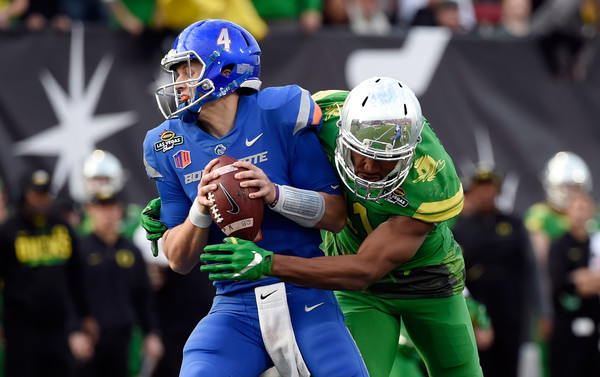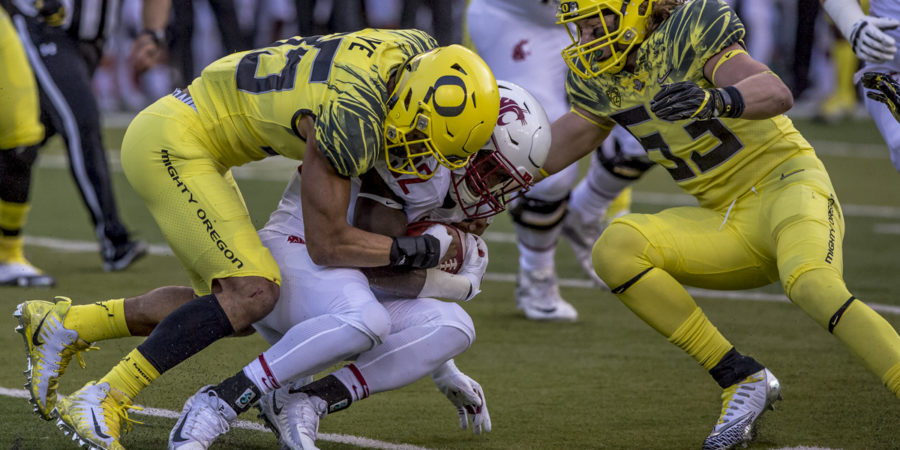What a difference two years can make.
At the conclusion of the 2016 season, no sane person would even dream of asking the question as to whether in two years, could it be feasible for Oregon to rest its hopes and dreams for success on a defense that was ranked as one of the worst in college football. If you need proof, see Oregon’s final standing nationally across an array of major statistical categories:
- 126th (out of 128 FBS teams) in scoring defense
- 121st in rushing defense
- 113th in passing defense
- 126th in total defense
- Tied for 118th in turnovers forced
That’s what the Duck defense under the guidance of former defensive coordinator Brady Hoke looked like. And in large part, that’s what ultimately served as the catalyst that led to head coach Mark Helfrich’s ouster at the end of the season.
Then came Jim Leavitt, the once maligned head coach at USF who helped engineer defensive turnarounds with San Francisco 49ers (2011-14) and at the University of Colorado (2015-16) before Willie Taggart hired him as the new Duck defensive coordinator in December of 2016.
Fast-forward a year and a half later, and it’s virtually inarguable that no player (save for maybe Justin Herbert) or coach has had a greater on-field impact for the Ducks than Leavitt.
In his first year as Oregon’s defensive coordinator, Leavitt pulled off perhaps the most impressive one-year reclamation project of his career, as the Ducks enjoyed significant defensive improvement across the board in those aforementioned major statistical categories. Most notable was their improvement in rushing defense, total defense, and turnovers forced, where the Ducks finished 25th, 46th, and 23rd in the nation, respectively.
Even more impressive was the fact Leavitt did all of this with virtually the same personnel that Hoke and Helfrich had a season before. Troy Dye was still Troy Dye, but he finally received some help, as players like Jalen Jelks, Justin Hollins, La’Mar Winston, and Henry Mondeaux all enjoyed breakout seasons, while true freshmen such as Thomas Graham and Jordon Scott clearly established themselves as building blocks for the future.

Each of those players return (excluding Mondeaux), along with a group of key contributors that includes Austin Faoliu, Deommodore Lenoir, and Ugo Amadi that could have the Ducks legitimately competing to be one of the best defenses in the conference – as long as Leavitt can continue developing this group along their current trajectory.
Depth, however, will be this unit’s Achilles’ heel.
In fact, more so than most seasons in recent memory, the question as to whether the Ducks will be able to rely on their defense will rest squarely on their ability to avoid the injury bug.
Yes this group has the coaching acumen and the talent along its starting 11 to compete with anyone in the Pac-12, but the Ducks still don’t have proven depth behind those players to confidently maintain momentum if/when injuries strike.
Along the defensive line, redshirt junior Gary Baker is an emerging bright spot coming off an encouraging spring, but there’s little else to get excited about at this point, especially if senior Malik Young and Miami (Fla.) transfer D.J. Johnson are ruled ineligible to participate this upcoming season.
The situation in the Oregon secondary may be even worse. The safety position, spearheaded by Amadi, has plenty of promise, but the depth behind Graham and Lenoir at corner is virtually non-existent, as the Ducks will be relying on two true freshmen (Verone McKinley and Kahlef Hailassie), a JUCO transfer (Haki Woods), and a grad transfer (Tim Hough) to provide support.
Linebacker may offer the most hope if the Ducks are forced to rely on their depth. The core consisting of Dye, Hollins, and Winston is nails, while players such as Kaulana Apelu, Keith Simms, Bryson Young, and Sampson Niu each have varying levels of experience and proven ability. Additionally, the Ducks expect to receive a boost from redshirt freshman Isaac Slade-Matautia, and a trio of true freshmen in Adrian Jackson, MJ Cunningham, and Andrew Johnson.
If Oregon can avoid injury in key spots, then there’s no reason why Leavitt’s defense shouldn’t be able to shoulder a significant load in the event Oregon’s offense struggles to find reliable footing throughout the season.
If not, and depth fails to reveal itself through fall camp and the early portion of the season, then what is currently perceived as an area of strength could rather quickly devolve into a glaring area of weakness.


The key is can the dline stay healthy enough to compete with Washington and Stanford.